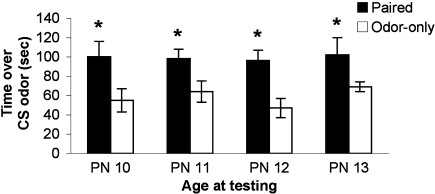Figure 2.
Pups were odor-0.5 mA shock conditioned for 2 (PN8–9), 3 (PN8–10), 4 (PN8–11) or 5 (PN8–12) consecutive days and tested during the postsensitive period on either PN10, PN11, PN12 or PN13, which are ages when amygdala-dependent fear conditioning can occur (n = 7–8/group). The result is expressed as cumulative data from the three testing trials. All experimental Paired odor-shock pups continued to exhibit a relative preference to the conditioned odor despite continued odor-shock conditioning following the termination of the sensitive period. Each pup was tested only once. Asterisk represents a significant difference from each of the other groups (p < 0.05).

